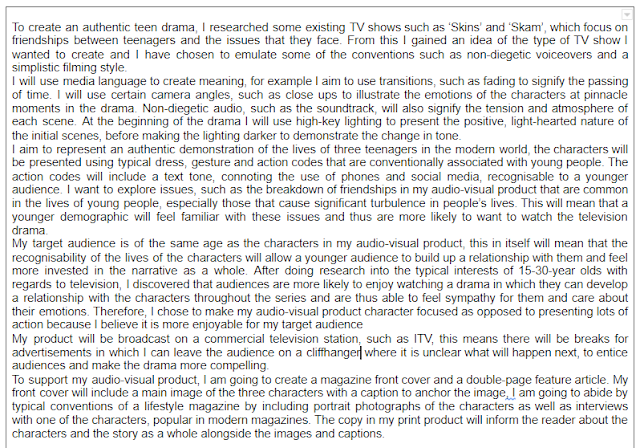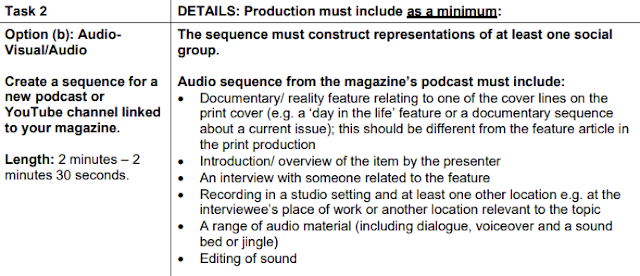Just listened to your podcasts. Obviously, I can't give you feedback but just wanted to say...
Supporting students from Cheslyn Hay Academy, Part of Windsor Academy Trust
NEA Aims & Intentions Document
Live Lesson at 11:00am on Monday 25th January
SMART START
The often visited Media Quiz checking that you can link theories and theorists. The year 12 students use this every lesson and now over half the class gets full marks every time (the order of questions and answers changes, so not just a familiarity thing). Therefore, I highly recommend taking this quiz on a regular basis; it takes less than 3 minutes. The minimum expectation for today is to achieve 20/26 at this point in the course. If you get below that, please try again.
INTRODUCTION
The Aims & Intentions document is the only assessed non-exam piece of writing you complete for A-Level media. It is short but it's worth a suprising amount of marks; 17% of the total Component 3 marks!
The Aims and Intentions document should be written BEFORE you start the NEA, so should always be written in the future tense, E.g. "I will..." or "It is my intention to...", etc.
You are restricted to a maximum of 500 words for this document but your probably won't be wondering what to write; it'll be getting what you need to write down to just 500 words.
SUCCESS CRITERIA
To begin with, let's have a look at the success criteria;
Use evidence from your research into: similar products; the industry context; your target audience, as well as theoretical perspectives, to explain your decisions:
- How and why will you use media language in your cross-media production?
- How and why will you construct representations of individuals, groups and issues/events?
- How will you target your intended audience?
- How will your production conform to its industry context? How will your cross-media production demonstrate digital convergence?
- Explain how you intend to use media language in your production, e.g. visual codes, technical codes, narrative and design.
- You should include people in your products to allow you to construct appropriate representations. Outline how you intend to do this, e.g. costume, gestures, setting, props, voices, etc
- Who is the intended audience for your production (it says in the requirements below). How do you intend to target this audience in your products? How do you intend to use model of address to target your audience (informal, formal, direct, etc). How will your product appeal to your target audience?
- How do you intend to use the conventions of the genre to illustrate the industry context (context identified in the requirements below).
- You should refer specifically to the research you completed. What similar products did you examine? What did you take from that research (conventions, stereotypes, etc).
- A should refer to each of the magazine elements (front cover, double-page spread, advertorial).
- A final paragraph should tie all your products together, referring to the podcast and explaining how it complements your main print product.
- Refer specifically to elements of our theoretical framework (reference theories / theorists).
- Use product-specific terminology and language (masthead, page furniture, close-up, caption, anchor, stand first, sound bed, fade-in, jingle, on-location interview, etc)
Audio Blocks
I have been informed (by Joe & Cole) that the AudioBlocks subscription has run out. It will be a few days before I can renew the subscription so, in the meantime, use free sound effects websites. A few are listed below;
If you are having difficulty finding a specific sound that you need to complete your podcast, let me know and I'll join the search!
Annoucement
I've posted the Theory Summary document we spoke about on our Google Classroom. Hope it helps.
5th Jan - 25 Jan
At the start of each of these timetabled lessons, you should take our media quiz, maintaining a familiarity with our theoretical framework. I will be monitoring results live! I will base the register on who completes this quiz (i.e. you need to complete the quiz to get an attendance 'present' mark).
NEA Completion & Support
Ok, with mock exams and remote learning requirements it's not a clean start to the term. Unfortunately, once again, I have to shield until the 1st Feb. Really sorry!
With all of this in mind, I have extended the deadline for the podcast NEA which means, despite the exams and disruption, you should now have plenty of time to plan and record your podcast. You have 3 weeks to complete the work and the final submission date is 25th January, 9:00am.
As usual, I will be online during our timetabled lessons to answer any questions you have relating to the use of the software which, in this case, is Adobe Audition (remember, I can't help you with the creative aspects of the NEA or provide any feedback).
Hopefully see you soon!
Finally, a reminder of the NEA requirements for this element.













